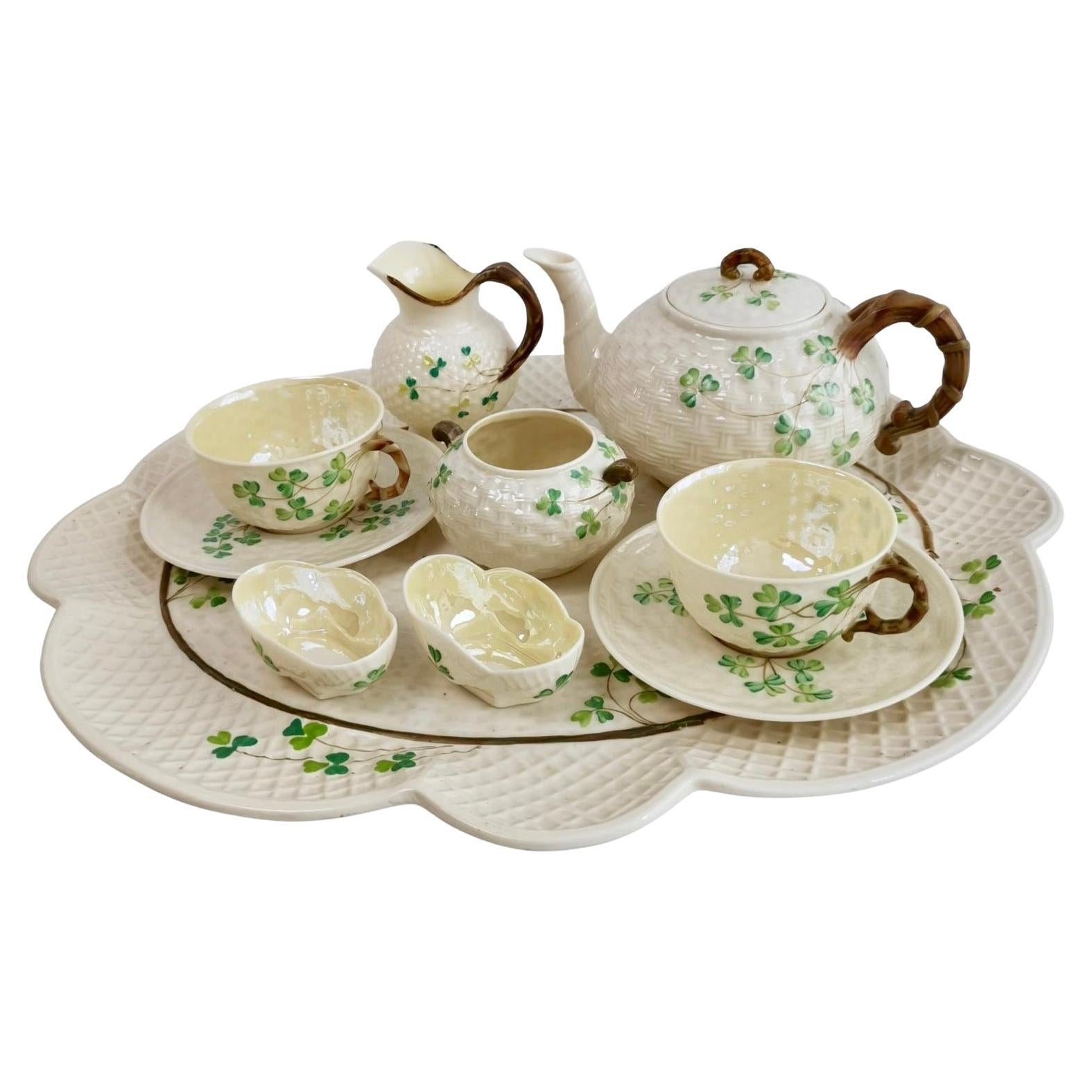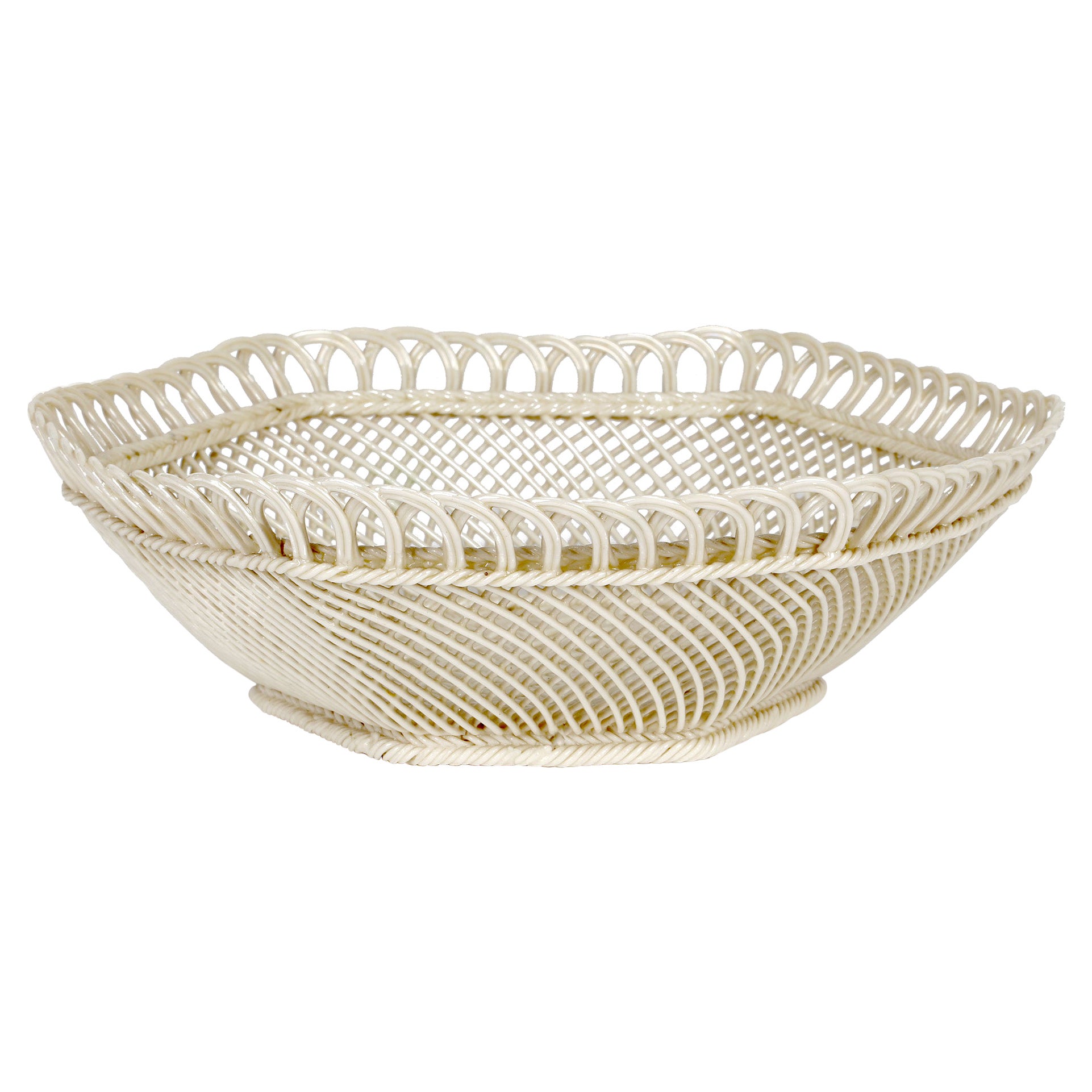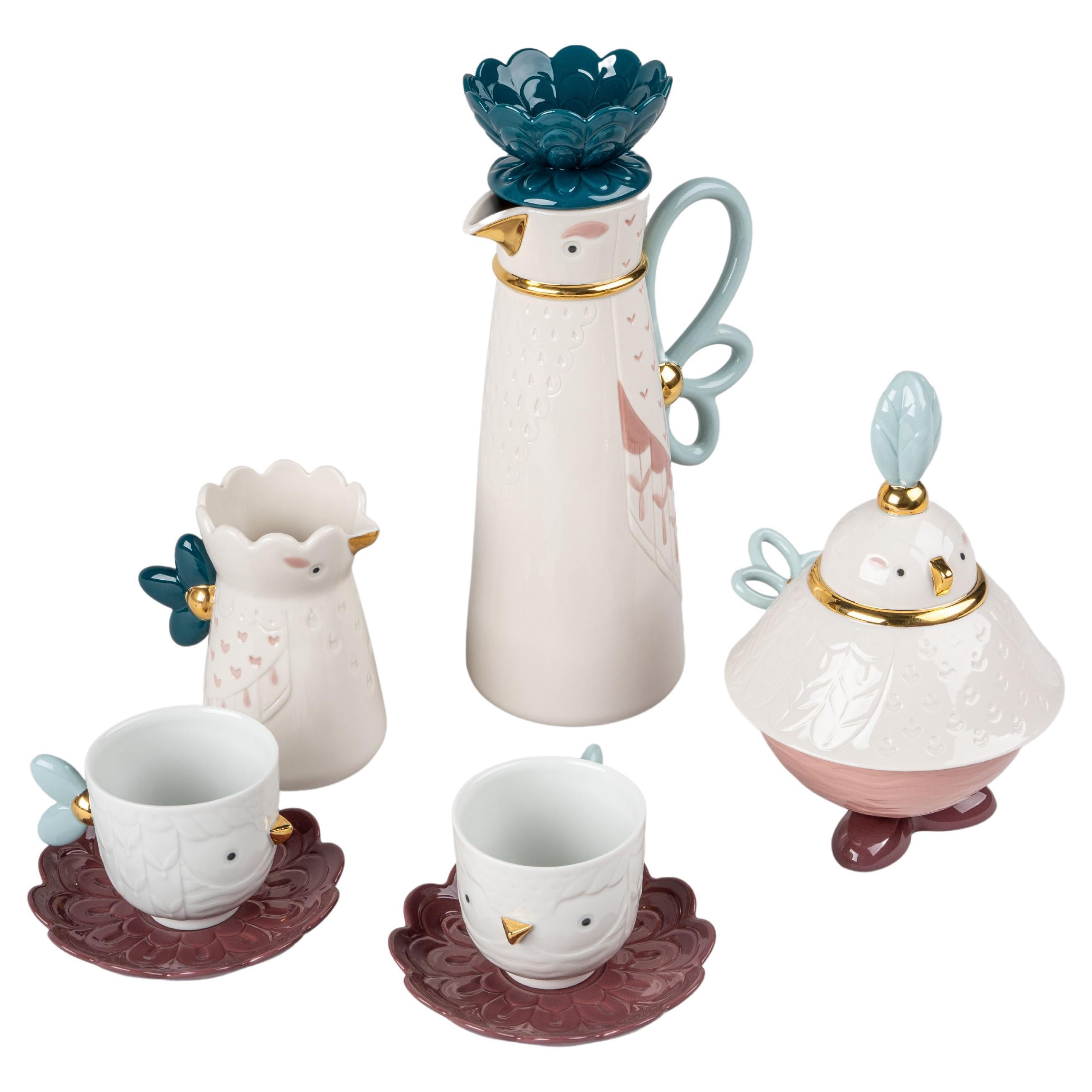Items Similar to Belleek Cabaret Tea Set, Cream Cob Lustre, Erne, Victorian, 1890s
Want more images or videos?
Request additional images or videos from the seller
1 of 16
Belleek Cabaret Tea Set, Cream Cob Lustre, Erne, Victorian, 1890s
About the Item
This is an extremely rare Belleek cabaret set for two, or "tête-à-tête", made in the Erne series brought out in the 1890s. The items carry the 2nd Black Mark, used between 1891 and 1926. The set consists of a teapot, a milk jug, a sugar bowl, two teacups and saucers, and a large matching tray.
This set is very fine and with its restrained cream-white colour it would make a wonderful wedding gift!
If you ever thought Belleek fine china looks, sounds and feels unique, you are right. There is a back story to this extraordinarily fine Irish eggshell porcelain, which has an unusually high amount of "frit" and therefore is thinner and finer than any other china.
Pottery in Belleek (in the now Northern-Irish area of Fermanagh) had started in 1849 with John Caldwell Bloomfield, who was a wealthy land owner. During the Irish famine he realised that unless he would find a way for his tenants to make a profit off the land, they would starve. Agriculture had become impossible due to the agricultural diseases. This caused millions to starve and more millions to leave. As an amateur mineralogist, John Caldwell Bloomfield realised that his land had exactly the right mineral deposits to be used as clay for porcelain. He involved several investors and scientists and after many years of research, trial, error, the building of a railway line to import coal from England, and building a factory, the Belleek pottery resulted, employing the local people and soon producing the finest china made with clay from the Belleek area.
What had started as a way to fend off famine among the local tenants had became a story of incredible success by the 1880s as Queen Victoria fell in love with the fine white china and the many homely, slightly bizarre but nature-loving designs; this was different from English tradition, yet it was very much to the taste of the British who had developed a real love for home-made fine china since it was introduced in the late 18th Century. Belleek not only brought out many tea services, but started a new tradition of intricately woven porcelain baskets. Soon the English nobility started to place big orders and the pottery is still flourishing today and selling its wares the world over, while in England most potteries have long disappeared.
Belleek made many cabaret services, often called breakfast services or "tête-à-tête" services; these were used to carry breakfast tea up to the bedroom. Queen Victoria bought one in the Echinus style during a visit to the factory in the 1860s, and ever since Belleek's cabaret services have been in great demand. Nowadays there are very few of these left and it is rare to find a full service like this.
The Erne series was named after the river right besides the Belleek factory. This river forms the border between the Republic of Ireland and Northern Ireland, with the factory on the Northern Irish end of the bridge at Belleek. The pattern seems to be a play on the baskets and nets of the fishermen who once fished the abundant trout and salmon on the river Erne and the lake that belongs to it.
The items carry the second Black Mark, which was used between 1891 and 1926, however the very fine quality of the porcelain indicates that most pieces of the set are more likely to be from the 1890s than from the 20th Century. You will see that the shade of cob lustre is different on each item; this is normal for Belleek tea sets as they were often assembled over time, and Belleek was notorious for always slightly changing their colours.
Condition report The set is in near-perfect antique condition, with only one small flaw: there is a faint star crack in the bottom of the sugar bowl. But as the bowl will not be used for hot liquids, the bowl is still fine to use. Other than this the set is free from any damage, repairs or crazing.
Antique porcelain is never perfect. Kilns were fired on coal in the 1800s, and this meant that china from that period can have some firing specks from flying particles. British makers were also known for their experimentation, and sometimes this resulted in technically imperfect results. Due to the shrinkage in the kiln, items can have small firing lines or develop crazing over time, which should not be seen as damage but as an imperfection of the maker's recipes, probably unknown at the time of making. Items have often been used for many years and can have normal signs of wear, and gilt can have signs of slight disintegration even if never handled. I will reflect any damage, repairs, obvious stress marks, crazing or heavy wear in the item description but some minor scratches, nicks, stains and gilt disintegration can be normal for vintage items and need to be taken into account.
There is widespread confusion on the internet about the difference between chips and nicks, or hairlines and cracks. I will reflect any damage as truthfully as I can, i.e. a nick is a tiny bit of damage smaller than 1mm and a chip is something you can easily see with the eye; a glazing line is a break in the glazing only; hairline is extremely tight and/or superficial and not picked up by the finger; and a crack is obvious both to the eye and the finger. Etcetera - I try to be as accurate as I can and please feel free to ask questions or request more detailed pictures!
Dimensions The pot stands 11cm (4.3") high to the top of the finial and measures 20cm (7.9") from handle to spout. The jug stands 7cm (2.75") high and measures 10.25cm (4.15") from mouth to handle. Bowl stands 5cm (2") high and is 9.3cm (3.75") in diameter. Teacup is 8.8cm (3.5") diameter, saucer is 13cm (5.15") diameter. The tray measures 43cm (17") diameter.
- Creator:Belleek Pottery Ltd. (Maker)
- Dimensions:Height: 1 in (2.54 cm)Width: 1 in (2.54 cm)Depth: 1 in (2.54 cm)
- Style:Victorian (In the Style Of)
- Materials and Techniques:
- Place of Origin:
- Period:
- Date of Manufacture:1891-1926
- Condition:Wear consistent with age and use. In excellent antique condition without any repairs, crazing or wear, a very faint star crack in the bottom of sugar bowl.
- Seller Location:London, GB
- Reference Number:
About the Seller
5.0
Platinum Seller
These expertly vetted sellers are 1stDibs' most experienced sellers and are rated highest by our customers.
Established in 2016
1stDibs seller since 2019
208 sales on 1stDibs
Typical response time: <1 hour
- ShippingRetrieving quote...Ships From: London, United Kingdom
- Return PolicyA return for this item may be initiated within 14 days of delivery.
More From This SellerView All
- Belleek Cabaret Tea Set for Two, Cream Grass Pattern, Victorian 1863-1891By Belleek Pottery Ltd.Located in London, GBThis is a beautiful and very rare Belleek cabaret set in the Grass design, consisting of a teapot, two teacups and saucers, a milk jug and a lidded sugar bowl, all placed on a large tray. All items carry the 1st Black Mark, which was used between 1863 and 1891. It is extremely rare to come across an entire cabaret set of these antique items, particularly when in such fabulous condition, so this is a rare opportunity! If you ever thought Belleek fine china looks, sounds and feels unique, you are right. There is a back story to this extraordinarily fine Irish eggshell porcelain, which has an unusually high amount of "frit" and therefore is thinner and finer than any other china. Pottery in Belleek (in the now Northern-Irish area of Fermanagh) had started in 1849 with John Caldwell Bloomfield, who was a wealthy land owner. During the Irish famine...Category
Antique Late 19th Century Northern Irish Victorian Tea Sets
MaterialsPorcelain
- Belleek Cabaret Tea Set for Two, Shamrock Pattern, 1891-1946By Belleek Pottery Ltd.Located in London, GBThis is a rare and gorgeous Belleek cabaret tea service, or dejeuner set, in the famous Shamrock design, consisting of a teapot, two teacups and saucers, a milk jug, a sugar bowl, and a salt and pepper, all placed on a large matching tray. It is extremely rare to come across an entire cabaret set of these antique items, particularly when in such good condition, so this is a rare opportunity! If you ever thought Belleek fine china looks, sounds and feels unique, you are right. There is a back story to this extraordinarily fine Irish eggshell porcelain, which has an unusually high amount of "frit" and therefore is thinner and finer than any other china. Pottery in Belleek (in the now Northern-Irish area of Fermanagh) had started in 1849 with John Caldwell Bloomfield, who was a wealthy land owner. During the Irish famine...Category
Antique Late 19th Century Northern Irish Victorian Tea Sets
MaterialsPorcelain
- Belleek Coffee Cup Trio, Shamrock Pattern, 1891-1926By Belleek Pottery Ltd.Located in London, GBThis is a very charming coffee cup trio made by Belleek in the Shamrock design, consisting of a coffee cup, a saucer and a little cake plate. It has the 2nd Black Mark, which was used between 1891 and 1926. Given the quality of the porcelain we think the date of production is probably closer to 1891 than 1926. If you ever thought Belleek fine china looks, sounds and feels unique, you are right. There is a back story to this extraordinarily fine Irish eggshell porcelain, which has an unusually high amount of "frit" and therefore is thinner and finer than any other china. Pottery in Belleek (in the now Northern-Irish area of Fermanagh) had started in 1849 with John Caldwell Bloomfield, who was a wealthy land owner. During the Irish famine...Category
Antique Late 19th Century Northern Irish Arts and Crafts Tea Sets
MaterialsPorcelain
- Swansea Porcelain Tea Set, Tea & Breakfast Cup White and Gilt, Regency ca 1820By Swansea PorcelainLocated in London, GBOn offer is a beautiful porcelain tea set made by Swansea around the year 1820, which was the Regency era. The set consists of a white and gilt decorated teacup and a larger "breakfa...Category
Antique 1820s Welsh Regency Tea Sets
MaterialsPorcelain
- Grainger Worcester Tea Set, Rococo Revival, Sevres-Style Birds, circa 1830By Grainger WorcesterLocated in London, GBThis is a tea set produced by Grainger Worcester in circa 1830, which was the Rococo Revival era. The set is decorated with birds and consists of a teapot, teapot stand or cake plate and two narrow cups and saucers. Grainger was one of the leading factories in Worcester in the 19th century. It started in the early days of British bone china production at the very beginning of the century, and was merged with Royal Worcester about 100 years later. During this era they were among the leaders of china production, producing exceptionally finely painted and sculpted forms, often jewelled, pierced or reticulated and decorated with exceptional art work. This set is potted in the Rococo Revival style and closely resembles tea services made by Henry Daniel - Grainger was known for making close and very nice imitations of the first class designs by Daniel. The teapot has a nice handle with a large thumb rest and a collared rim. The cups, which are probably coffee cups as they are narrow, have beautifully shaped "rustic bean" handles that closely resemble Henry Daniel's designs of that era. The items are simple white with beautifully hand painted birds in the Sevres style, as well as gilt vine motif. The rims are gadrooned, as was popular around this time. An image of the teapot shape and pattern 1681 (although a more luxurious version with feet, which this teapot doesn't have) can be found in Michael Berthoud's "An Anthology of British Teapots...Category
Antique 1830s English Rococo Revival Tea Sets
MaterialsPorcelain
- Samuel Alcock Solitaire Tea Set, Beige, Pale Yellow and Flowers, ca 1833By Samuel Alcock & Co.Located in London, GBA solitaire tea set consisting of a teapot with cover and a trio consisting of a teacup, a coffee cup and a saucer, in “rustic loop” shape, with beige ground with rich pale yellow an...Category
Antique 1830s English Rococo Revival Tea Sets
MaterialsPorcelain
You May Also Like
- Belleek Irish Antique Porcelain Hexagonal Shaped Lustre Glazed BasketBy Belleek Pottery Ltd.Located in Bishop's Stortford, HertfordshireAn exceptional and finely made Irish woven porcelain hexagonal shaped basket made by Belleek and dating from the 19th century. The stunning basket stan...Category
Antique 19th Century Irish High Victorian Decorative Baskets
MaterialsPorcelain
- Kawki Coffee/Tea SetBy LladroLocated in New York City, NYThe Kawki collection is composed of an imaginative, fun and tender coffee set created for Lladró by Polish designer Aleksandra Zeromska. Inspired by Slavic folklore and the author's ...Category
21st Century and Contemporary Spanish Porcelain
MaterialsPorcelain
- Paris Porcelain Tea SetLocated in New Orleans, LAFabulous Porcelain Tea SetCategory
Antique 19th Century French Tea Sets
MaterialsPorcelain
- A Large Belleek Willets Porcelain Tea Service, circa 1890Located in New York, NYConsisting of pot, sugar, creamer (restored), two trays and six cups and saucers. Delicately gilded on an ivory ground.Category
Antique 1890s American Tea Sets
MaterialsPorcelain
- A Large Belleek Willets Porcelain Tea Service, circa 1890Located in New York, NYConsisting of pot, sugar, creamer (restored), two trays and six cups and saucers. Delicately gilded on an ivory ground.Category
Antique 1890s Tea Sets
MaterialsPorcelain
- Antique Tea Set for 9 Person, C. Tielsch, 1890s, GermanyBy Carl Tielsch & Co. 1Located in Bastogne, BEExquisite porcelain antique tea set. The end of the XIX century! C. Tielsch, Germany. Tableware for 9 people. 31 subjects Hand-painted. I have p...Category
Antique 1890s German Tea Sets
MaterialsPorcelain
Recently Viewed
View AllMore Ways To Browse
Gift Set
Victorian Nature
1890s Antique Victorian
Antique Cream Dining Set
Antique Victorian Tea
Antique Tea Cans
Small Tea Set
Antique Cream Dining Room Sets
English Tea Set
High Tea Set
English Tea Set Silver
Rare Tea Set
White Tea Set
Cream Tea Set
1880s Dining Room Set
Antique Tea Sign
Tea Set And Tray
Tea Set Tray





